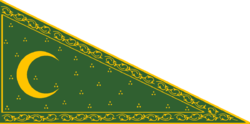Çakaristan–Order of the Holy Lakes relations: Difference between revisions
No edit summary |
|||
| (3 intermediate revisions by 3 users not shown) | |||
| Line 21: | Line 21: | ||
* 1717: Çakaristan opens a consulate general in [[Ghawlama]]. | * 1717: Çakaristan opens a consulate general in [[Ghawlama]]. | ||
* 1725: Anya Chetti replaces [[Priya Sinha]] as ambassador to Hurmu. | * 1725: Anya Chetti replaces [[Priya Sinha]] as ambassador to Hurmu. | ||
* 1739: A [[Çakaristan 2025 FMF World Cup bid friendly matches|friendly football match]] between the nations is held in [[Agra]]. | |||
== Ambassadors == | == Ambassadors == | ||
| Line 26: | Line 27: | ||
* [[Ravi Sharma]], 1691–1708 <small>(1698–1704: ambassador of the Greater Apollonian Empire to Hurmu)</small> | * [[Ravi Sharma]], 1691–1708 <small>(1698–1704: ambassador of the Greater Apollonian Empire to Hurmu)</small> | ||
* [[Priya Sinha]], 1708–1725 | * [[Priya Sinha]], 1708–1725 | ||
* Anya Chetti, 1725-present | * [[Anya Chetti]], 1725-present | ||
=== From Hurmu to Çakaristan === | === From Hurmu to Çakaristan === | ||
Latest revision as of 14:07, 6 January 2025
The relations between Çakaristan and Hurmu are close and warm. Relations are characterised by shared geographical heritage, shared border (both physical and maritime, along with border cooperation), and the membership of Shahanshah Jaaguzan and his family in the Order of the Holy Lakes.
Çakaristan and Hurmu share a border on the Apollonian continent, going from the Bay of Shields in the west (by Tyrador and Nuristan) to the Antican Sea in the east. Moreover, Çakaristan and Hurmu share a border around most of Hurmu's Al-Khadra District since the end of the Arboric Civil War.
Between 1698 and 1704, Çakaristan formed part of the Greater Apollonian Empire. Hurmu recognized the Greater Apollonian Empire the legal and sovereign successor of Çakaristan, and, following the dissolution of the Greater Apollonian Empire, Hurmu recognized Çakaristan as the legal and sovereign successor to the Greater Apollonian Empire.
Timeline
- 1690: Çakaristan and Hurmu opened up relations upon Hurmu's independence in 1690. A treaty was concluded and signed later the same year.
- 1691: Ambassadors formally exchanged. Ravi Sharma is accredited as Çakari ambassador to Hurmu in a ceremony in the Palace of the Elenaran. Emiilia Ask is accredited as Hurmu ambassador to Çakaristan in a lavish ceremony.
- 1693: Hurmu opened a consulate-general in Suqutra and a smaller consulate in Myvar.
- 1698: Çakaristan becomes part of the Greater Apollonian Empire. Hurmu recognizes the Greater Apollonian Empire the legal and sovereign successor of Çakaristan. During this time, Hurmu found relations difficult to navigate, due to the perception among ethnic Hurmudans of Jingdao's unresolved debt for the Hurmu genocide. Hurmu and Jingdao had not had relations, and with Jingdao and Çakaristan merging to form the Empire, the Greater Apollonian Empire also became the legal successor to Jingdao.
- 1704: Greater Apollonian Empire dissolved; Hurmu recognized Çakaristan as the legal and sovereign successor to the Greater Apollonian Empire.
- 1706: Çakaristan opens a consulate in Tyrador.
- 1708: Former senator Priya Sinha replaces Ravi Sharma as ambassador to Hurmu.
- 1717: Çakaristan opens a consulate general in Ghawlama.
- 1725: Anya Chetti replaces Priya Sinha as ambassador to Hurmu.
- 1739: A friendly football match between the nations is held in Agra.
Ambassadors
From Çakaristan to Hurmu
- Ravi Sharma, 1691–1708 (1698–1704: ambassador of the Greater Apollonian Empire to Hurmu)
- Priya Sinha, 1708–1725
- Anya Chetti, 1725-present
From Hurmu to Çakaristan
- Emiilia Ask, 1691–1717
- Osman Guadalim al-Osman, 1717–present
Missions
- Hurmu has an embassy in Agra, a consulate general in Suqutra, and a consulate in Myvar.
- Çakaristan has an embassy in Huyenkula, a consulate general in Ghawlama, and a consulate in Tyrador.

